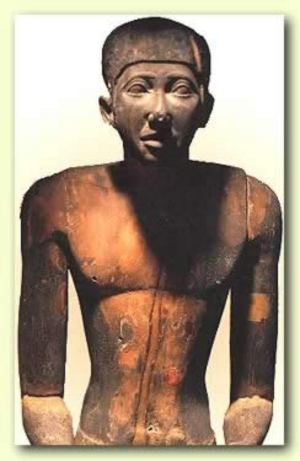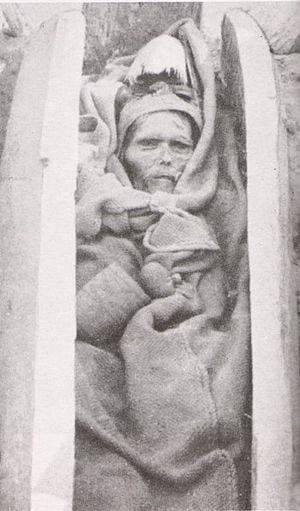Young people all over the globe enjoy an eyeful of mummies, curses, magic and excitement with theatrical releases like ‘The Mummy’ and ‘The Mummy Returns’ in 1999 and 2001. And while handsome actor Arnold Vosloo certainly made a dashing and exciting character in the movies, how many people know there actually was an Imhotep? In the popular movies, Imhotep was portrayed as a man in love with Aneksunamun, a man willing to risk all in his present life and the next to keep her, even to the point of bringing her back to life- but fact is stranger than fiction, and sometimes even more romantic than in the movies. The real Imhotep truly was a high priest, but he wasn’t buried alive, nor locked in a sarcophagus filled with teeming scarabs.
Imhotep, whose name means, “The one that comes in peace”, lived over 4,000 years ago. Born a common man around 2980 B.C., he rose to prominence during the reign of Djoser, who ruled from 2630 to 2611 BC, in the 3rd Egyptian dynasty. Imhotep eventually served four pharaohs and is credited with building the first stone structure in the world, a step pyramid located in Saqqara, Egypt. Not much is known of Imhotep’s ancestry, but historians believe he was born in Ankhtowë, a sort of suburb of the city of Memphis… not Elvis’ hometown in Tennessee, but the Memphis in Egypt, which used to be the Egyptian capital. Still others think he came from a village called Gebelein, which is found south of the ancient city of Thebes. Because of his intelligence, hard work and natural gifts, he rose quickly to positions of importance, but Imhotep was more than an architect. He was also a priest, a scribe, a poet, an astrologer, a vizier – a sort of highly placed executive officer, and a chief minister. Even more so, he was also known as the true father of medicine. He is known to have written medical and instructional texts which were unfortunately destroyed when Alexandria burned.
Greek writers often made reference to him and his writings, though Hippocrates is the more familiarly known founder of modern medicine, including his well-known Hippocratic oath, which all medical students take upon their graduation. Imhotep was also known as a philosopher and poet, and is credited with coming up with the phrase, “Eat, drink and be merry for tomorrow we shall die”. The influence of the Egyptians cast a giant influence over many cultures, and became the foundations of many new cultures.
Imhotep’s knowledge was widely known, respected and accepted during the rise of the Greek influence. As the true father of medicine, Imhotep left a legacy to those who came after him. Even the Encyclopedia Britannica says of him, “The evidence afforded by Egyptian and Greek texts supports the view that Imhotep’s reputation was very respected in early times… and his prestige increased with the lapse of centuries and his temples in Greek times were the centers of medical teachings. He is believed to have written a papyrus that contains over 90 anatomical terms and covered over two-dozen types of injuries. He may very well have been one of the founding fathers of a school of medicine in Memphis.
It is believed that Imhotep not only diagnosed and treated over 200 diseases, but that he had a hand in treating tuberculosis, appendicitis, and arthritis. He was known to perform surgery and was one of the first to wash his hands and clean his utensils before doing so, though it took ‘modern man’ nearly two thousand years to realize what germs were and how dangerous they could be in the medical field of healing and surgery. Imhotep was also one of the first to experiment with the use of plants for medical uses, and knew enough about human anatomy to locate and identify vital organs and to explain how the circulatory system worked.
Here’s where the romance part comes in. Because Imhotep was such a good physician and surgeon, he became so widely known that even the pharaoh heard about him. Pharaoh Khasekhem and his wife were expecting a child, and when his wife went into labor, she began to have difficulty. Naturally, the pharaoh called Imhotep to help her, and he not only saved her life, but also succeeded in delivering her of a healthy baby boy, the Prince Djoser. But Imhotep and his wife were also expecting a child, and while he was helping the Queen deliver hers, his own wife went into labor. Unfortunately, she also had difficulties, but he was unable to save her, as he was with the Pharaoh’s wife at the time. Imhotep’s wife died during childbirth, though his son survived. Heartbroken and despondent, Imhotep remained with his wife’s body throughout the 40 day ritual of mummification and burial preparation, grieving her loss. He buried her somewhere in the desert near Saqqara. Some years later, he returned to the area and built the first stone-block pyramid the world had ever seen, rising almost 200 feet into the air. It took up a space of nearly three hundred by six hundred yards of ground.
While many have doubted the existence of an Imhotep over the centuries, that all changed when symbols representing him were discovered written in the base of a statue within a pyramid that to this day remains the oldest surviving stone structure in the world. This inscription, on one of the King’s statues, calls Imhotep, the ‘chancellor of the king of lower Egypt’, the ‘first one under the king’, the ‘administrator of the great mansion’, the ‘hereditary Noble’ and the ‘High Priest of Heliopolis’. He is also called the ‘Chief sculptor’ and ‘Chief carpenter’. Not bad for someone who wasn’t born into the nobility. The Romans, including the Emperors Claudius, honored him and Tiberius praised him in writings on the walls of their Egyptian temples. He is, perhaps, the only historical figure to be worshipped by four different world religions.
Imhotep lived to old age, and is believed to be buried in the deserts of Saqqara, quite possibly near his wife’s resting place. Near the Serapeum in Memphis, a temple was erected to honor him, and even today, three thousand years after his death, nearly every museum in Egypt boasts a statue or two of the gifted man. As late as 1999, serious efforts were underway to find Imhotep’s mummy. In fact, the discovery of his mummy may well prove to rank as highly as the discovery of King Tut’s tomb in the annals of Egyptology. Still, thousands of dollars and years later, his tomb has yet to be found. Could it be that there is possibly a curse against finding it? Well, time will tell. Until then, Imhotep may rest undisturbed, satisfied with his true legacy.






